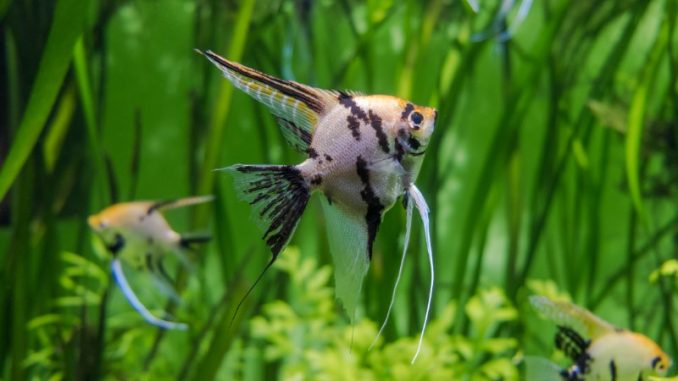
Freshwater angelfish are from the Cichlidae family and Pterophyllum genus, while saltwater angelfish belong to the Pomacanthidae family and seven genera.
Freshwater angelfish are semi-aggressive and from three different species: scalare, altum, and leopoldi. The fish are found in slow-moving rivers in the Amazon Basin and are easy-moderate to care for.
Some freshwater and saltwater angelfish are readily available in pet stores, while others are rare.
TABLE OF CONTENTS
Silver Angelfish

| Care level: | Temperament: | Color: | Lifespan: | Size: |
| Easy | Semi-aggressive | Silver with three black stripes | 10–12 years | 6 inches |
| Water temperature: | Water pH: | Tank size: | Diet: | Scientific name: |
| 76–84 °F | 6.5–8.0 | 30 gallons | Omnivore | Pterophyllum scalare var. Silver |
The silver angelfish is one of the most popular freshwater angelfish, and was one of the first Pterophyllum scalare angelfish types to be kept in captivity. This fish is widely used for cross-breeding, and the zebra silver angelfish is one of these cross-bred results.
The silver angelfish is a hardy fish with a silver body and three vertical stripes. One black stripe starts below the fish’s red eye and extends downward, while the other two stripes run vertically across the fish’s body.
Silver angelfish look similar to wild angelfish that live in the slow-running waters of the Amazon Basin. A silver angelfish tank should have rocks, plants, and low lighting to mimic the floodplains, lakes, and tributaries in the Amazon. Keep silver angelfish in a school of six or more.
Zebra Angelfish

| Care level: | Temperament: | Color: | Lifespan: | Size: |
| Easy | Peaceful | Silver body with four to six black or dark brown stripes | 10–15 years | 6 inches |
| Water temperature: | Water pH: | Tank size: | Diet: | Scientific name: |
| 75–82 °F | 6.8–7.0 | 30 gallons | Omnivore | Pterophyllum scalare var. Zebra |
Zebra angelfish are popular among beginner aquarists because the fish are easy to care for. Silver angelfish and zebra angelfish look similar with their silver bodies; however, a zebra angelfish has four to six dark brown or black longitudinal stripes down its body and the fish is smaller.
The zebra angelfish is a more active and faster swimmer than other angelfish.
The tank conditions for zebra angelfish should mimic the angelfish’s natural habitat in the Orinoco Basin, Amazon Basin, and rivers in the Guiana Shield. Zebra angelfish prefer warm water conditions, fine gravel substrate, driftwood, and low lighting in the tank. Add some large leaf plants like Amazon sword so the zebra angelfish have a place to hide.
Avoid housing zebra angelfish with large or smaller fish in your community tank because bigger fish may bully the zebra angelfish, and zebra angelfish eat any small fish that fit in their mouths.
Altum “Orinoco” Angelfish
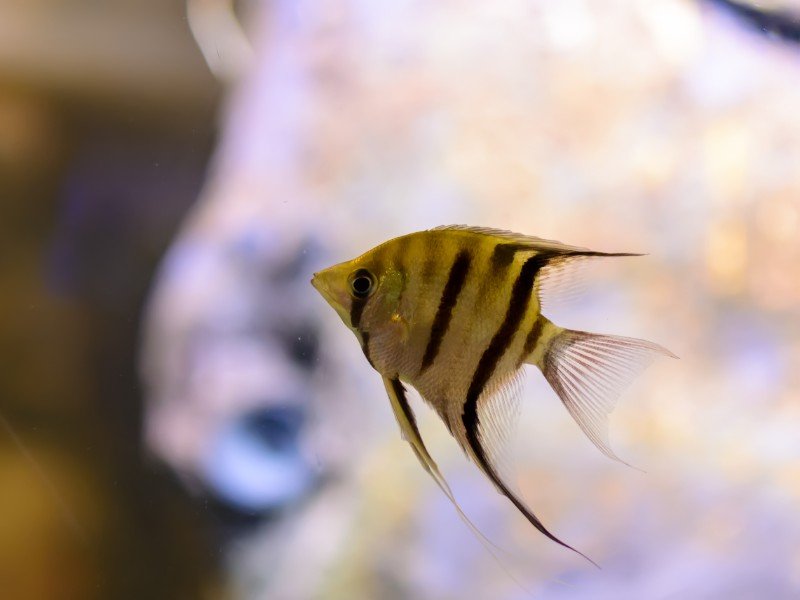
| Care level: | Temperament: | Color: | Lifespan: | Size: |
| Moderate | Semi-aggressive | Silver with four dark brown/black stripes | 5+ years | 7–10 inches |
| Water temperature: | Water pH: | Tank size: | Diet: | Scientific name: |
| 72–90 °F | 4.8–6.2 | 55 gallons | Omnivore | Pterophyllum altum |
Altum angelfish are rarer than silver or zebra angelfish. These angelfish are hardy and good centerpiece fishes. Altums are also called Orinoco angelfish, deep angelfish, altum orinoco angelfish, and altum angels.
The altum angelfish has a disk-shaped light silver body with four longitudinal dark brown-red stripes. The fish has a notch on the upper area of its snout and red striations on its fins. The dorsal fin of the adult altum angelfish has a blue-green hue and red spots.
Altums are native to the upper Rio Negro and upper Rio Orinocco tributaries in Colombia and Venezuela. Altum angelfish thrive in a large, deep tank with soft substrate, dim lighting, and lots of floating plants.
Most altums are wild-caught. The fish are picky eaters and prefer live food or regurgitated food from other fish in the tank.
Koi Angelfish
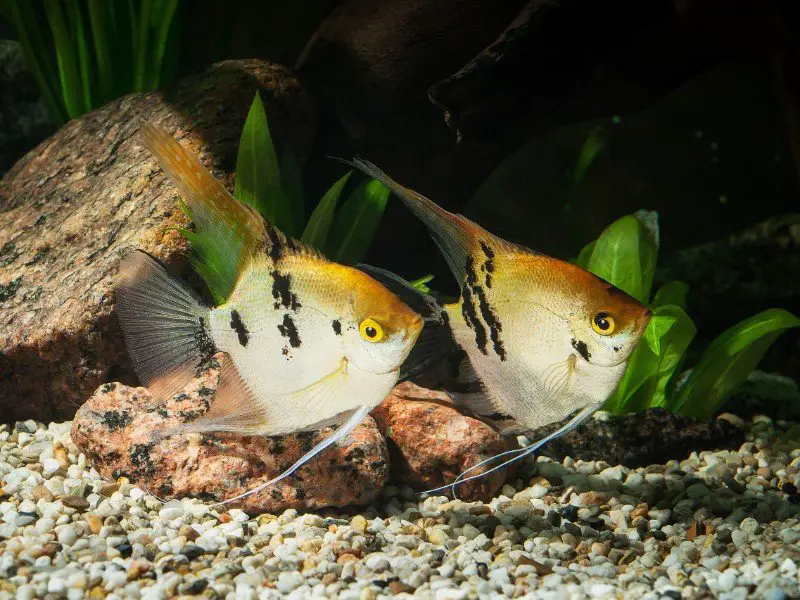
| Care level: | Temperament: | Color: | Lifespan: | Size: |
| Moderate | Semi-aggressive | Mottled black, white, orange, and yellow | 10+ years | 6 inches |
| Water temperature: | Water pH: | Tank size: | Diet: | Scientific name: |
| 76–86 °F | 6.0–7.4 | 40 gallons | Omnivore | Pterophyllum scalare var. Koi |
Koi angelfish share their mottled coloration with the ornamental carp, the koi fish. No two koi angelfish are alike. Each fish has its own random patterns and coloration.
Koi angelfish have a tall, thin, diamond-shaped body with triangular anal and dorsal fins that are as tall as the length of the fish’s bodies. The base color of the koi angelfish is white or silver with various patterns in black, yellow, and orange.
Koi angelfish are native to river systems in the Amazon Basin. Tank-bred koi angelfish thrive in an aquarium with a gentle water flow, lots of plants, and rock formations. Keep koi angelfish individually, in a mated pair, or a school of six with other community fish.
Beware of fin nippers in your tank, which harass and nip the fins of koi angelfish. Koi angelfish are known to eat guppies, young tetras, dwarf shrimp, and small invertebrates.
Platinum Angelfish

| Care level: | Temperament: | Color: | Lifespan: | Size: |
| Easy | Semi-aggressive | Silver with blue or green fins | 10 years | 6 inches |
| Water temperature: | Water pH: | Tank size: | Diet: | Scientific name: |
| 75–82°F | 5.8–7.0 | 30 gallons | Omnivore | Pterophyllum scalare var. Platinum |
Platinum angelfish have a brilliant, silvery sheen and long fins with a hue of blue or green. The platinum angelfish’s dorsal and anal fins are just as long as the length of the fish’s body.
Wild platinum angelfish are native to the warm, calm flood plains and waterways in the Amazon Basin. The fish live in areas with lots of tree roots and plants and should be housed in a tank with lots of driftwood and plants, and soft, acidic water.
Young platinum angelfish need frequent water changes and a varied diet. Adult platinum angelfish are hardy and better suited than young platinum angelfish for beginner aquarists. Keep platinum angelfish singularly, in a mated pair, or in a school of six.
Leopard Angelfish

| Care level: | Temperament: | Color: | Lifespan: | Size: |
| Easy | Peaceful but territorial | Pearly silver with dark brown/black spots and patterns | 7–8 years | 6 inches |
| Water temperature: | Water pH: | Tank size: | Diet: | Scientific name: |
| 76–86°F | 6.0–7.4 | 40 gallons | Omnivore | Pterophyllum scalare var. Leopard |
Leopard angelfish have an elegant appearance with leopard-like spots and patterns. In a heavily planted aquarium, leopard angelfish make an excellent centerpiece. Leopard angelfish are popular among aquarists because the fish are easy to keep and breed.
Some leopard angelfish have a shiny pearly silver body and black leopard spots, while other varieties have gold, yellow, or blue patterns. To keep the fish’s spots visible and prevent fading, ensure the tank has lighting conditions as close to natural light as possible.
Leopard angelfish are indigenous to the northern parts of the Amazon Basin. The tank environment should mimic the natural habitat of the leopard angelfish and be heavily planted with a gentle water inflow. Beware of fin nippers that bite at the long, flowing fins of the leopard angelfish.
Albino Angelfish
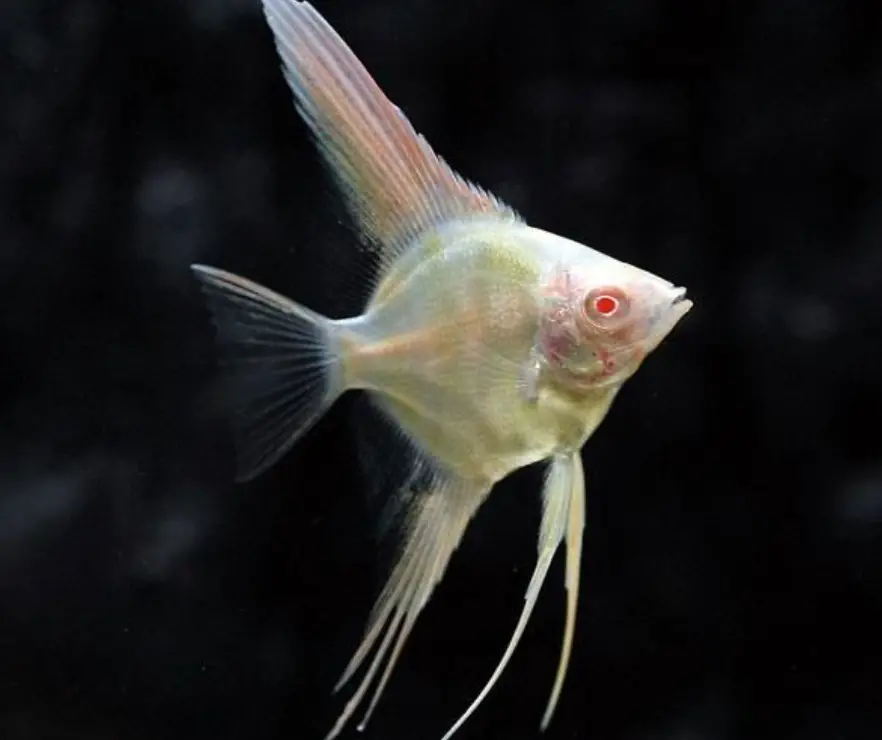
| Care level: | Temperament: | Color: | Lifespan: | Size: |
| Moderate | Semi-aggressive | White or silver with a yellow-orange ring around its red eye | 5–8 years | 6 inches |
| Water temperature: | Water pH: | Tank size: | Diet: | Scientific name: |
| 75–82°F | 5.5–7.0 | 30 gallons | Omnivore | Pterophyllum scalare var. Albino |
Albino angelfish have no pigment, so the fish’s bodies are completely white or silver depending on the light. Two to three pale gold stripes are visible on the sides of the fish’s bodies in the right light conditions. Albino angelfish have pink eyes that are surrounded by a yellow-orange ring.
While albino angelfish are susceptible to diseases and don’t live long, the fish are a unique addition to a fish collection.
Albino angelfish are native to the Amazon Basin, but the fish aren’t a common find in their natural habitat. Ensure the fish’s tank is decorated with bogwood, rock work, and driftwood to give the albino angelfish several hiding spots.
Medium-sized peaceful fish make great tank mates, but small fish don’t make good tank mates because albino angelfish like to ambush these fish.
Leopold’s Angelfish
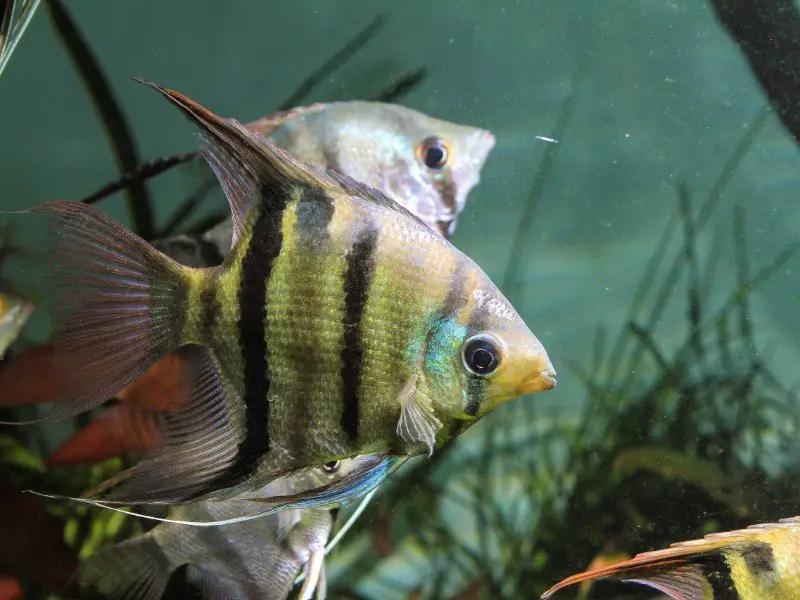
| Care level: | Temperament: | Color: | Lifespan: | Size: |
| Moderate | Very aggressive | Gold-silverish with bronze/black stripes | 5–10 years | 2–3 inches |
| Water temperature: | Water pH: | Tank size: | Diet: | Scientific name: |
| 77–82.4°F | 5.0–6.2 | 35 gallons | Omnivore | Pterophyllum leopoldi |
Leopold’s angelfish are rare but beautiful aquarium fish. They are also called teardrop angelfish, dwarf angelfish, or roman-nosed angelfish.
The fish have no pre-dorsal notch. Leopold’s have a black spot below the base of their dorsal fin. The fish have gold-silverish bodies with black or bronze stripes. Leopold’s angelfish have short dorsal and anal fins.
The Leopold’s angelfish’s natural habitat is the Amazon River between Manacapuru and Santarem, Rupununi River, and Essequibo River. The fish’s tank should include plenty of plants and have lots of standing branches and floating plants to replicate the Leopold’s angelfish’s natural habitat.
Good tankmates for the Leopold’s angelfish are non-aggressive catfish, medium-sized characins, and small- and medium-sized loaches. Avoid active fish that bully Leopold’s angelfish.
Panda Angelfish
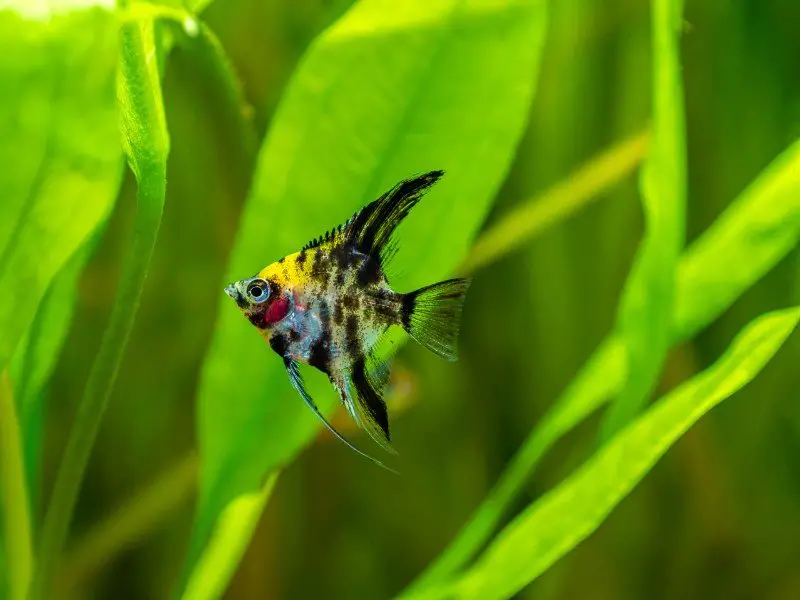
| Care level: | Temperament: | Color: | Lifespan: | Size: |
| Easy | Semi-aggressive | Platinum white with a blue sheen and black blotches | 10+ years | 6 inches |
| Water temperature: | Water pH: | Tank size: | Diet: | Scientific name: |
| 76–84°F | 6.5–8.0 | 30 gallons | Omnivore | Pterophyllum scalare var. Panda |
Panda angelfish have unique coloring resembling a panda. The fish are hardy and suitable for newbie aquarists.
Although all panda angelfish have a platinum white body with a blue sheen and black blotches, no two panda angelfish have identical markings.
Tank-bred panda angelfish prefer tall, well-planted aquariums with a soft substrate and low lighting. Panda angelfish prefer living in a group of five or more. These fish are sensitive to changes in water conditions.
Marble Angelfish

| Care level: | Temperament: | Color: | Lifespan: | Size: |
| Easy | Semi-aggressive | White body with black markings and a gold tint | 12 years | 6 inches |
| Water temperature: | Water pH: | Tank size: | Diet: | Scientific name: |
| 76–84°F | 6.5–8.0 | 30 gallons | Omnivore | Pterophyllum scalare var. Marble |
Marble angelfish have white diamond-shaped bodies with a gold tint along the top of their bodies and bottom of the dorsal fin. The black markings on the sides give this fish a marbled appearance.
Marble angelfish are hardy and easy to care for and aren’t sensitive to changes in water conditions.
The ancestors of the marble angelfish are native to the Amazon Basin. The ideal tank environment for these fish has low lighting, plants, rocks, and driftwood. Marble angelfish tolerate temperature fluctuations.
Great tankmates for the marble angelfish are zebra and kuhli loaches, corydoras catfish, platy fish, swordtails, and other medium-sized cichlids and tetras.
Choosing & Caring for Different Types of Angelfish
Angelfish are one of the most easily recognizable freshwater fish species in aquariums. With their long, flowy fins and diamond-shaped bodies with various patterns, angelfish bring color to any tank.
Caring for angelfish requires a tank that replicates the fish’s natural habitat (the slow-moving waters in the Amazon Basin). The tank should have dim lighting and have a slow current, a smooth substrate, and lots of driftwood, broadleaf plants, and floating plants.
When choosing which angelfish is best, keep in mind:
- The ease or difficulty in caring for the angelfish
- What color or pattern will stand out or fit in with your aquarium theme
- What other fish species are already in your tank and whether these make good tankmates for angelfish
- How easy it is to buy the angelfish because some angelfish are rare
You can house angelfish from the Pterophyllum scalare species together, such as:
- Silver angelfish
- Zebra angelfish
- Koi angelfish
- Platinum angelfish
- Leopard angelfish
- Marble angelfish
- Panda angelfish

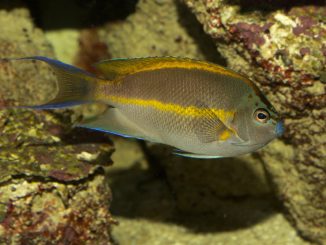
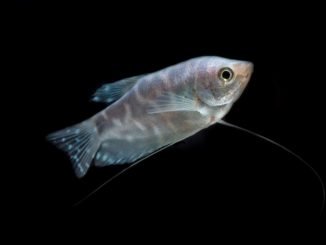
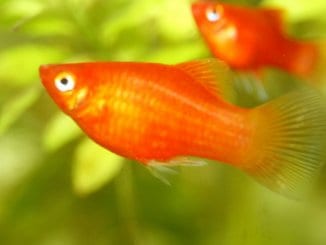
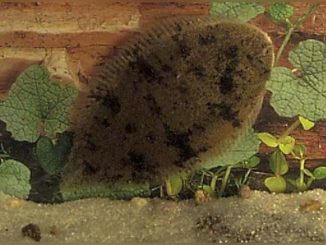
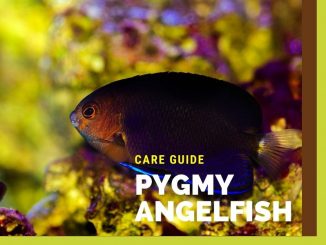
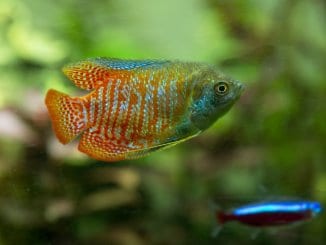
Be the first to comment